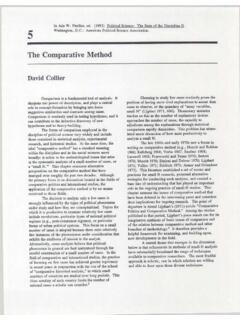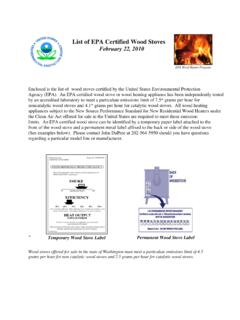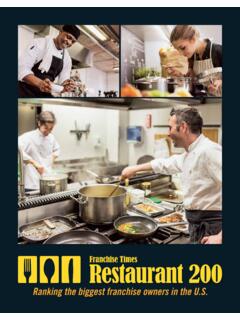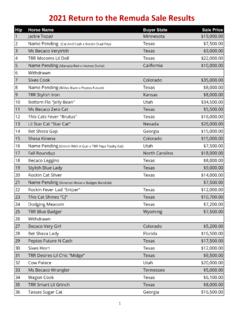Transcription of The Teacher UnderstandingProcessTracing
1 Understanding Process TracingDavid Collier,University of California, BerkeleyABSTRACTP rocess tracing is a fundamental tool of qualitative analysis. This method isoften invoked by scholars who carry out within-case analysis based on qualitative data, yetfrequently it is neither adequately understood nor rigorously applied. This deficit moti-vates this article, which offers a new framework for carrying out process refor-mulation integrates discussions of process tracing and causal-process observations, givesgreater attention to description as a key contribution, and emphasizes the causal sequencein which process-tracing observations can be situated. In the current period of major inno-vation inquantitativetools for causal inference, this reformulation is part of a wider, par-allel effort to achieve greater systematization ofqualitativemethods.
2 A key point here isthat these methods can add inferential leverage that is often lacking in quantitative anal-ysis. This article is accompanied by online teaching exercises, focused on four examplesfrom American politics, two from comparative politics, three from international relations,and one from public tracing is a fundamental tool of qualitativeanalysis. In the framework presented here,1it isdefined as the systematic examination of diagnosticevidence selected and analyzed in light of researchquestions and hypotheses posed by the tracing can contribute decisively both to describing polit-ical and social phenomena and to evaluating causal claims. Georgeand Bennett have played the leading role in developing thismethod as an essential form of within-case analysis,2and Fenno s soaking and poking is a kindred research the idea of process tracing is often invoked by schol-ars as they examine qualitative data, too often this tool is neitherwell understood nor rigorously applied.
3 Relatedly, the field of qual-itative methods in political science in sharp contrast to quanti-tative methods is inadequately equipped with procedures forteaching basic research tools, including process two-fold deficit motivates this article, which offers a newframework for understanding, applying, and teaching process trac-ing. The approach is distinctive in three vis- -vis evidence on which process trac-ing focuses corresponds to what Collier, Brady, and Seawright(2010a) call causal-process observations, or CPOs. The idea ofCPOs highlights the contrast between (a) the empirical foun-dation of qualitative research, and (b) the data matrices ana-lyzed by quantitative researchers, which may be called data-setobservations (DSOs). Some of the literature on which this arti-cle draws ( , Brady 2010; Freedman 2010a; Mahoney 2010)formulates arguments in terms of CPOs, rather than in termsof process tracing per se.
4 The present article treats these meth-odological tools as two facets of the same research , the article consistently refers to process tracing to avoid applying two labels to what is basically the Careful description is a foundation of process tracing,a perspective emphasized by Mahoney (2010, 125 31). Processtracing inherently analyzes trajectories of change and causa-tion, but the analysis fails if the phenomena observed at eachstep in this trajectory are not adequately described. Hence, whatin a sense is static description is a crucial building block inanalyzing the processes being Process tracing gives close attention to sequences ofindependent, dependent, and intervening variables. Again, wefollow Mahoney, who has productively advanced this EXERCISESThis new formulation of process tracing is accompanied by onlineteaching exercises4that encompass diverse substantive Politics: Fenno (1977) on members of Congress; Brady(2010) on the 2000 Presidential election; Skocpol et al.
5 (2000)on civic associations; and Weaver (2007) on crime Politics: Lerner (1958) on social change in a Turk-ish village; and Rogowski (2010) on the interaction of theoryand case Relations: Tannenwald (1999) on the US nucleartaboo after World War II; Bennett (2010) on the Fashoda cri-sis, Germany s expansion of military goals duringWorldWar I,and Soviet nonintervention in Eastern Europe in 1989; andSchultz (2001) on democracy and coercive Collieris Chancellor s Professor of Political Science in the Department ofPolitical Science at the University of California, Berkeley. He can be reached October Health: Freedman (2010a) on major breakthroughs inthe history of Fiction: The Sherlock Holmes story Silver blaze (posted online with the exercises) serves as the basis for anexercise, and also as a running example in parts of the follow-ing story is not social science, yet it providesvivid illustrations of process tracing and is an engaging text TRACING, PRIOR KNOWLEDGE, AND DIAGNOSTICEVIDENCEP rocess tracing, to reiterate, is an analytic tool for drawing descrip-tive and causal inferences from diagnostic pieces of evidence often understood as part of a temporal sequence of events orphenomena.
6 Given the close engagement with cases and the cen-trality of fine-grained case knowledge, process tracing can makedecisive contributions to diverse research objectives, including:(a) identifying novel political and social phenomena and system-atically describing them; (b) evaluating prior explanatory hypoth-eses, discovering new hypotheses, and assessing these new causalclaims; (c) gaining insight into causal mechanisms; and (d) pro-viding an alternative means compared with conventional regres-sion analysis and inference based on statistical models ofaddressing challenging problems such as reciprocal causation,spuriousness, and selection bias. Thus, qualitative tools can addleverage in quantitative analysis. They can also strengthen causalinference in small-N designs based on the matching and contrast-ing of cases designs which have great value, but whose contri-bution to causal inference urgently needs to be supplemented bywithin-case tracing requires finding diagnostic evidence that pro-vides the basis for descriptive and causal inference.
7 How does theresearcher establish that a given piece of evidence is diagnostic?6 Identifying evidence that can be interpreted as , we distinguish four interrelated types of knowledge extending distinctions offered by Waltz (1979), whose ideas areimportant in the international relations examples included Frameworks. A first type of prior knowledge involvessets of interrelated concepts, often accompanied by general ideasof how the concepts can be operationalized. These frameworksthereby identify and link the topics seen as meriting analyticattention. The framework often points to the counterfactualsthat conceptually establish what it means for a given phenom-enon to be absent, that is, the contrast space (Garfinkel 1981)that organizes the Empirical Regularities. These are established patterns8in the relationships among two or more phenomena.
8 Waltz(1979, 1) states that this is not simply .. a relationship thathas been found, but .. one that has been found repeatedly. The corresponding ifa, thenb (1979, 1) connection may beviewed as causal, or it may be understood builds on these recurring regularities by more tightlyconnecting them as a set of insights into a particular behavioror phenomenon (Waltz 1979, 2). Thus, many social scientistsseek to build theory by collecting carefully verified, intercon-nected hypotheses. Theory-II. A final type of prior knowledge entails not only inter-connected empirical regularities (Theory-I), but also a set ofstatements that explain them, that is, offering explanations ofwhythese regularities occur (Waltz 1979, 5).Theory-II may alsobe called an explanatory is clear in the exercises, some studies are explicit and pre-cise about the prior knowledge that frames the research, whereasfor other studies it is necessary to consult a wider literature tounderstand the theoretical background.
9 Unfortunately, as inves-tigators write up their research, they may overstate the coher-ence of the findings vis- -vis prior knowledge sometimes makingit hard to identify the theoretical starting point. Reconstructingthis starting point can require detective work which is some-times needed in evaluating diagnostic evidence in some of this backdrop, we consider the contribution of pro-cess tracing to descriptive and causal INFERENCEC areful description is fundamental in all research, and causalinference whether assessed with qualitative or quantitative tools depends on engagement with case knowledge in pro-cess tracing can provide a good foundation for addressing key point must be underscored again. As a tool of causalinference, process tracing focuses on the unfolding of events orsituationsover time.
10 Yet grasping this unfolding is impossible ifone cannot adequately describe an event or situationat one pointin time. Hence, thedescriptivecomponent of process tracing beginsnot with observing change or sequence, but rather with takinggood snapshots at a series of specific moments. To characterize aprocess, we must be able to characterize key steps in the process,which in turn permits good analysis of change and (2010, 127 28) illustrates descriptive inference in pro-cess tracing with Tannenwald s (1999) study of the NuclearTaboo. 11 Tannenwald argues that the horrified reaction to theuse of nuclear weapons at the end of the World War II created anuclear taboo that strongly influenced later US nuclear policy,specifically decisions about the non-use of nuclear weapons dur-ing subsequent military crises.








